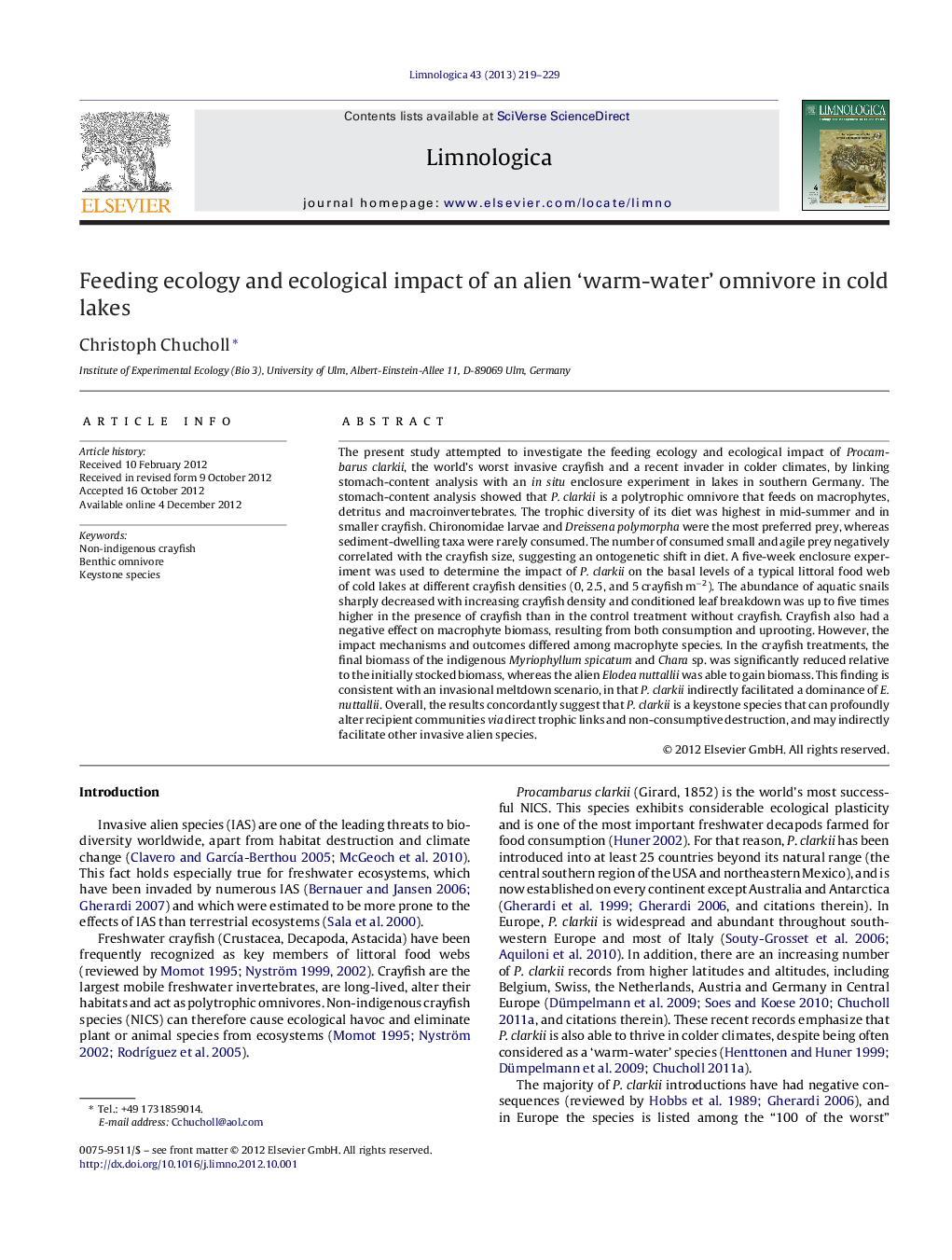| کد مقاله | کد نشریه | سال انتشار | مقاله انگلیسی | نسخه تمام متن |
|---|---|---|---|---|
| 6305665 | 1306972 | 2013 | 11 صفحه PDF | دانلود رایگان |
عنوان انگلیسی مقاله ISI
Feeding ecology and ecological impact of an alien 'warm-water' omnivore in cold lakes
ترجمه فارسی عنوان
تغذیه زیست محیطی و تاثیر زیست محیطی آب گرم "آب گرم" بیگانه در دریاچه های سرد
دانلود مقاله + سفارش ترجمه
دانلود مقاله ISI انگلیسی
رایگان برای ایرانیان
کلمات کلیدی
خرچنگ غیر محلی هرج و مرج بنفش، گونه های کیستون،
موضوعات مرتبط
علوم زیستی و بیوفناوری
علوم کشاورزی و بیولوژیک
علوم آبزیان
چکیده انگلیسی
The present study attempted to investigate the feeding ecology and ecological impact of Procambarus clarkii, the world's worst invasive crayfish and a recent invader in colder climates, by linking stomach-content analysis with an in situ enclosure experiment in lakes in southern Germany. The stomach-content analysis showed that P. clarkii is a polytrophic omnivore that feeds on macrophytes, detritus and macroinvertebrates. The trophic diversity of its diet was highest in mid-summer and in smaller crayfish. Chironomidae larvae and Dreissena polymorpha were the most preferred prey, whereas sediment-dwelling taxa were rarely consumed. The number of consumed small and agile prey negatively correlated with the crayfish size, suggesting an ontogenetic shift in diet. A five-week enclosure experiment was used to determine the impact of P. clarkii on the basal levels of a typical littoral food web of cold lakes at different crayfish densities (0, 2.5, and 5 crayfish mâ2). The abundance of aquatic snails sharply decreased with increasing crayfish density and conditioned leaf breakdown was up to five times higher in the presence of crayfish than in the control treatment without crayfish. Crayfish also had a negative effect on macrophyte biomass, resulting from both consumption and uprooting. However, the impact mechanisms and outcomes differed among macrophyte species. In the crayfish treatments, the final biomass of the indigenous Myriophyllum spicatum and Chara sp. was significantly reduced relative to the initially stocked biomass, whereas the alien Elodea nuttallii was able to gain biomass. This finding is consistent with an invasional meltdown scenario, in that P. clarkii indirectly facilitated a dominance of E. nuttallii. Overall, the results concordantly suggest that P. clarkii is a keystone species that can profoundly alter recipient communities via direct trophic links and non-consumptive destruction, and may indirectly facilitate other invasive alien species.
ناشر
Database: Elsevier - ScienceDirect (ساینس دایرکت)
Journal: Limnologica - Ecology and Management of Inland Waters - Volume 43, Issue 4, June 2013, Pages 219-229
Journal: Limnologica - Ecology and Management of Inland Waters - Volume 43, Issue 4, June 2013, Pages 219-229
نویسندگان
Christoph Chucholl,
